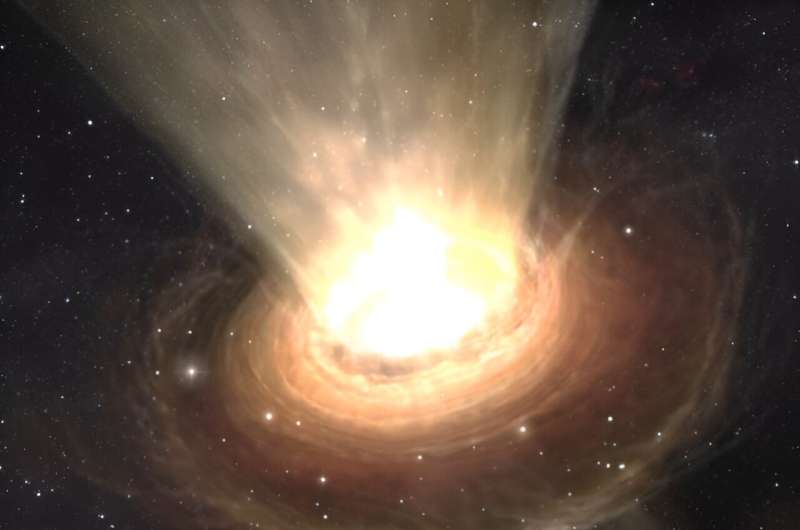This article has been reviewed according to Science X's editorial process and policies. Editors have highlighted the following attributes while ensuring the content's credibility:
fact-checked
peer-reviewed publication
trusted source
proofread
First map of outflows from nearby quasar I Zwicky 1

SRON astronomers have for the first time mapped the outflows from one of the closest quasars to Earth. Quasars are bright cores of galaxies powered by the supermassive black hole in their center. The team has probed gas outflows in I Zwicky 1, a close-by quasar, to map its system of clouds being blown away at tens to thousands of kilometers per second. Their findings are published in the journal Astronomy & Astrophysics.
Most galaxies, including our Milky Way, harbor a supermassive black hole in their center. These typically weigh millions of solar masses. Many of them keep lurking in the blackness of space, with little to give them away. Some have, however, large deposits of material in their vicinity to feed on. This turns the central region into a brilliant beacon, outshining the entire host galaxy.
Given their compact size and large distance from Earth, these active galactic nuclei appear as bright dots, like the Milky Way stars. This is also why they were historically classified as quasi-stellar objects (quasars).
Most quasars reside in the distant, early universe, but I Zwicky 1 is relatively close at less than a billion lightyears away from Earth. This provides astronomers with a convenient laboratory for studying the extreme conditions in quasars.
A team of astronomers led by Anna Juráňová (SRON), including Elisa Costantini (SRON), has now for the first time mapped its outflows. Using the Hubble Space Telescope, they recovered the properties of four outflows of ionized gas clouds, being blown out at speeds of 60, 280, 1950 and 2900 kilometers per second.
"I Zwicky 1 is very special in its properties," says Juráňová. "Other quasars have similar outflows, but in this one, everything is just right. Our viewing angle, the width of the lines in the spectrum, and so on. This allows us to dig much deeper into its processes. We have created a global picture of the motions of the ionized gas in a quasar, which is rare."
The team found that one of the outflows was trapped in the shadow of the other one. This results from the strong radiation from the quasar pushing the clouds out and away from the vicinity of the black hole. Ions of elements such as nitrogen, oxygen and carbon within the gas clouds absorb the quasar's ultraviolet light and get pushed away as a consequence. I Zwicky 1 is the nearest quasar offering concrete evidence of this mechanism at play.
The environment around I Zwicky 1 appears more dynamical than what astronomers often see around nearby supermassive black holes. Juráňová says, "Our data suggest that far more gas is being lifted and blown out from the disk around the black hole. Having this insight brings us closer to unraveling the way these supermassive black holes grow and interact with their surroundings."
More information: Astronomy & Astrophysics (2024).
Journal information: Astronomy & Astrophysics
Provided by SRON Netherlands Institute for Space Research




















